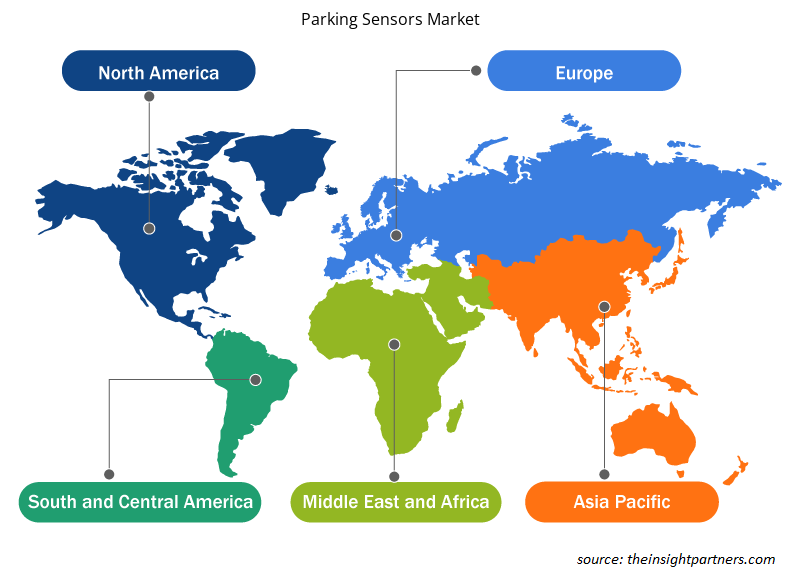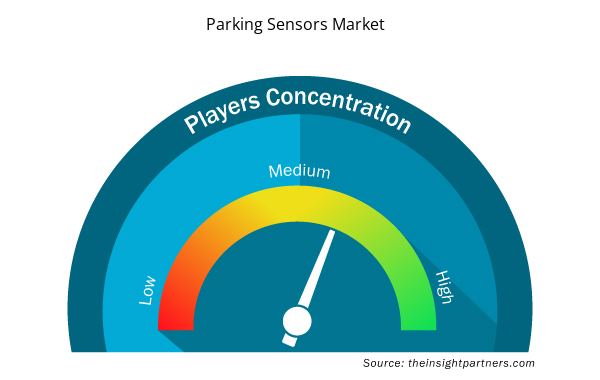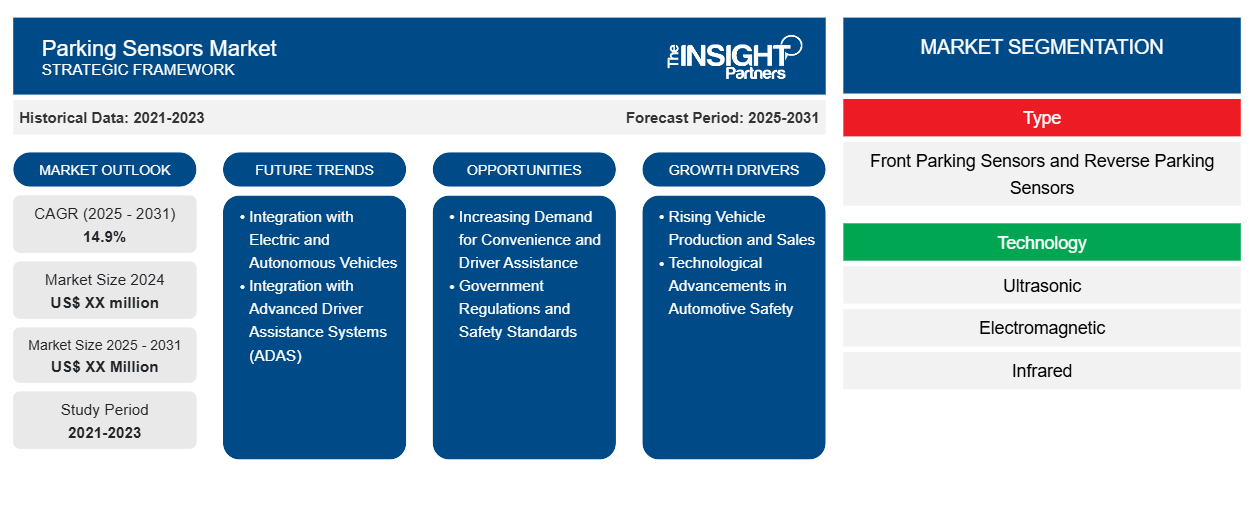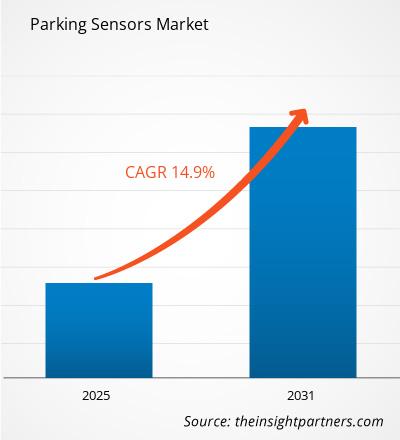Le marché des capteurs de stationnement devrait enregistrer un TCAC de 14,9 % de 2023 à 2031, avec une taille de marché passant de XX millions USD en 2023 à XX millions USD d'ici 2031.
Le rapport est segmenté par type (capteurs de stationnement avant et capteurs de stationnement arrière) ; technologie (ultrasons, électromagnétiques, infrarouges et laser) ; installation (OEM et marché secondaire) ; type de véhicule (véhicules utilitaires lourds, véhicules utilitaires légers et moyens et voitures particulières). L'analyse mondiale est ensuite décomposée au niveau régional et par principaux pays. Le rapport offre la valeur en USD pour l'analyse et les segments ci-dessus.
Objectif du rapport
Le rapport sur le marché des capteurs de stationnement de The Insight Partners vise à décrire le paysage actuel et la croissance future, les principaux facteurs moteurs, les défis et les opportunités. Cela fournira des informations à diverses parties prenantes commerciales, telles que :
- Fournisseurs/fabricants de technologie : pour comprendre l’évolution de la dynamique du marché et connaître les opportunités de croissance potentielles, leur permettant de prendre des décisions stratégiques éclairées.
- Investisseurs : Effectuer une analyse complète des tendances concernant le taux de croissance du marché, les projections financières du marché et les opportunités qui existent tout au long de la chaîne de valeur.
- Organismes de réglementation : Réglementer les politiques et surveiller les activités du marché dans le but de minimiser les abus, de préserver la confiance des investisseurs et de maintenir l’intégrité et la stabilité du marché.
Segmentation du marché des capteurs de stationnement
Taper
- Capteurs de stationnement avant et capteurs de stationnement arrière
Technologie
- Ultrasonique
- Électromagnétique
- Infrarouge
- Laser
Installation
- OEM et pièces de rechange
Type de véhicule
- Véhicules utilitaires lourds
- Véhicules utilitaires légers et moyens
- Voitures de tourisme
Type de véhicule
- Véhicules utilitaires lourds
- Véhicules utilitaires légers et moyens
- Voitures de tourisme
Personnalisez ce rapport en fonction de vos besoins
Vous bénéficierez d'une personnalisation gratuite de n'importe quel rapport, y compris de certaines parties de ce rapport, d'une analyse au niveau des pays, d'un pack de données Excel, ainsi que d'offres et de remises exceptionnelles pour les start-ups et les universités.
- Obtenez les principales tendances clés du marché de ce rapport.Cet échantillon GRATUIT comprendra une analyse de données, allant des tendances du marché aux estimations et prévisions.
Facteurs de croissance du marché des capteurs de stationnement
- Hausse de la production et des ventes de véhicules : La production et les ventes de véhicules, en particulier de voitures particulières, sont des moteurs majeurs du marché des capteurs de stationnement. L'industrie automobile mondiale ne cesse de croître en termes de nombre de véhicules sur les routes. En raison de la croissance de l'urbanisation et de la disponibilité réduite des places de stationnement, les capteurs de stationnement sont devenus indispensables pour les conducteurs pour se garer en toute sécurité dans des environnements exigus. De plus, de nombreux nouveaux modèles de véhicules sont équipés de capteurs de stationnement en standard ou en option, ce qui stimule encore davantage la demande du marché.
- Progrès technologiques en matière de sécurité automobile : les progrès en matière de technologie de sécurité automobile ont été un facteur essentiel de la croissance du marché des capteurs de stationnement. Les capteurs de stationnement avancés, qui impliquent généralement des technologies à ultrasons, électromagnétiques ou radar, sont aujourd'hui précis, fiables et plus abordables. L'intégration avec les systèmes avancés d'aide à la conduite (ADAS) et le développement des technologies d'aide au stationnement, notamment le stationnement automatique, apportent également davantage de fonctionnalités aux capteurs de stationnement. Cette innovation fait des capteurs de stationnement un produit « incontournable » dans les voitures, favorisant leur adoption.
Tendances futures du marché des capteurs de stationnement
- Intégration avec les véhicules électriques et autonomes : Les véhicules électriques et autonomes, de plus en plus populaires, devraient accroître le marché des capteurs de stationnement avec de grandes perspectives de croissance. Les véhicules électriques et autonomes nécessitent des capteurs de stationnement spéciaux en raison de la forme et du style de navigation uniques de ces véhicules. L'utilisation de nombreux véhicules autonomes garantira l'utilisation d'un certain nombre de capteurs de stationnement pour se garer sans assistance humaine dans divers environnements. En outre, la croissance de l'adoption des véhicules électriques, dont la plupart sont dotés de fonctions d'assistance au stationnement efficaces, augmentera la demande de capteurs de stationnement.
- Intégration avec les systèmes avancés d'aide à la conduite (ADAS) : une tendance importante sur le marché des capteurs de stationnement est l'intégration croissante des capteurs de stationnement avec des systèmes avancés d'aide à la conduite (ADAS) plus larges. Les véhicules devenant plus intelligents et plus autonomes, les capteurs de stationnement sont de plus en plus intégrés aux ADAS pour fournir aux conducteurs une assistance en temps réel et basée sur les données lors des manœuvres de stationnement. Cela comprend des fonctionnalités telles que la détection de collision, le stationnement automatique et l'assistance au stationnement avec des alertes visuelles et sonores. L'intégration des capteurs de stationnement à d'autres technologies ADAS, telles que les caméras, les radars et les capteurs à ultrasons, améliore la sécurité et la commodité globales du stationnement, ce qui en fait un élément clé du développement des véhicules semi-autonomes et autonomes.
Opportunités de marché pour les capteurs de stationnement
- Demande croissante de confort et d'assistance au conducteur : La demande de fonctionnalités de confort et de sécurité accrues dans les véhicules a conduit à l'intégration de capteurs de stationnement dans l'ensemble du véhicule. Les capteurs de stationnement facilitent le stationnement pour le conducteur d'une voiture et évitent les accidents dus à la collision avec un objet ou une autre voiture, ce qui se produit souvent dans les villes où la circulation est très dense. Cette commodité accrue ainsi que les fonctionnalités de sécurité améliorées ont créé une augmentation significative de l'adoption de capteurs de stationnement dans les véhicules low cost et haut de gamme.
- Réglementations gouvernementales et normes de sécurité : de plus en plus de gouvernements du monde entier imposent des restrictions en matière de sécurité des véhicules. En outre, cela a incité plusieurs pays à rendre les capteurs de stationnement obligatoires dans certaines catégories de véhicules, en particulier lorsqu'il s'agit de véhicules de plus grande taille comme les camions et les bus. Tant que la réglementation visant à sécuriser la vie des piétons et à prévenir les accidents à proximité des parkings et des garages se renforce, les fabricants sont incités à utiliser des capteurs de stationnement comme équipement standard pour garantir la sécurité des véhicules.
Aperçu régional du marché des capteurs de stationnement
Les tendances et facteurs régionaux influençant le marché des capteurs de stationnement tout au long de la période de prévision ont été expliqués en détail par les analystes d’Insight Partners. Cette section traite également des segments et de la géographie du marché des capteurs de stationnement en Amérique du Nord, en Europe, en Asie-Pacifique, au Moyen-Orient et en Afrique, ainsi qu’en Amérique du Sud et en Amérique centrale.

- Obtenez les données régionales spécifiques au marché des capteurs de stationnement
Portée du rapport sur le marché des capteurs de stationnement
| Attribut de rapport | Détails |
|---|---|
| Taille du marché en 2023 | XX millions de dollars américains |
| Taille du marché d'ici 2031 | XX millions de dollars américains |
| Taux de croissance annuel composé mondial (2023-2031) | 14,9% |
| Données historiques | 2021-2022 |
| Période de prévision | 2024-2031 |
| Segments couverts | Par type
|
| Régions et pays couverts | Amérique du Nord
|
| Leaders du marché et profils d'entreprises clés |
|
Densité des acteurs du marché des capteurs de stationnement : comprendre son impact sur la dynamique commerciale
Le marché des capteurs de stationnement connaît une croissance rapide, tirée par la demande croissante des utilisateurs finaux en raison de facteurs tels que l'évolution des préférences des consommateurs, les avancées technologiques et une plus grande sensibilisation aux avantages du produit. À mesure que la demande augmente, les entreprises élargissent leurs offres, innovent pour répondre aux besoins des consommateurs et capitalisent sur les tendances émergentes, ce qui alimente davantage la croissance du marché.
La densité des acteurs du marché fait référence à la répartition des entreprises ou des sociétés opérant sur un marché ou un secteur particulier. Elle indique le nombre de concurrents (acteurs du marché) présents sur un marché donné par rapport à sa taille ou à sa valeur marchande totale.
Les principales entreprises opérant sur le marché des capteurs de stationnement sont :
- Appareils analogiques, Inc.
- Continental AG
- Société Denso
- Semiconducteurs Freescale, Ltd.
- INRIX
Avis de non-responsabilité : les sociétés répertoriées ci-dessus ne sont pas classées dans un ordre particulier.

- Obtenez un aperçu des principaux acteurs du marché des capteurs de stationnement
Principaux arguments de vente
- Couverture complète : Le rapport couvre de manière exhaustive l’analyse des produits, des services, des types et des utilisateurs finaux du marché des capteurs de stationnement, offrant un paysage holistique.
- Analyse d’experts : Le rapport est compilé sur la base d’une compréhension approfondie des experts et analystes du secteur.
- Informations à jour : Le rapport garantit la pertinence commerciale en raison de sa couverture des informations récentes et des tendances des données.
- Options de personnalisation : ce rapport peut être personnalisé pour répondre aux exigences spécifiques du client et s'adapter parfaitement aux stratégies commerciales.
Le rapport de recherche sur le marché des capteurs de stationnement peut donc aider à ouvrir la voie au décodage et à la compréhension du scénario de l’industrie et des perspectives de croissance. Bien qu’il puisse y avoir quelques préoccupations valables, les avantages globaux de ce rapport ont tendance à l’emporter sur les inconvénients.
- Analyse historique (2 ans), année de base, prévision (7 ans) avec TCAC
- Analyse PEST et SWO
- Taille du marché Valeur / Volume - Mondial, Régional, Pays
- Industrie et paysage concurrentiel
- Ensemble de données Excel



Report Coverage
Revenue forecast, Company Analysis, Industry landscape, Growth factors, and Trends

Segment Covered
This text is related
to segments covered.

Regional Scope
North America, Europe, Asia Pacific, Middle East & Africa, South & Central America

Country Scope
This text is related
to country scope.
Questions fréquemment posées
Some of the customization options available based on the request are an additional 3-5 company profiles and country-specific analysis of 3-5 countries of your choice. Customizations are to be requested/discussed before making final order confirmation as our team would review the same and check the feasibility
The report can be delivered in PDF/PPT format; we can also share excel dataset based on the request
Integration with Electric and Autonomous Vehicles is anticipated to play a significant role in the global parking sensors market in the coming years
The major factors driving the parking sensors market are:
1. Rising Vehicle Production and Sales
2. Technological Advancements in Automotive Safety
The Parking Sensors Market is estimated to witness a CAGR of 14.9% from 2023 to 2031
Trends and growth analysis reports related to Electronics and Semiconductor : READ MORE..
1. Analog Devices, Inc
2. Continental AG
3. Denso Corporation
4. Freescale Semiconductor, Ltd.
5. INRIX
6. Nedap
7. NXP Semiconductors N.V
8. Parking Dynamics
9. Robert Bosch GmbH
10. Texas Instruments Incorporated
The Insight Partners performs research in 4 major stages: Data Collection & Secondary Research, Primary Research, Data Analysis and Data Triangulation & Final Review.
- Data Collection and Secondary Research:
As a market research and consulting firm operating from a decade, we have published and advised several client across the globe. First step for any study will start with an assessment of currently available data and insights from existing reports. Further, historical and current market information is collected from Investor Presentations, Annual Reports, SEC Filings, etc., and other information related to company’s performance and market positioning are gathered from Paid Databases (Factiva, Hoovers, and Reuters) and various other publications available in public domain.
Several associations trade associates, technical forums, institutes, societies and organization are accessed to gain technical as well as market related insights through their publications such as research papers, blogs and press releases related to the studies are referred to get cues about the market. Further, white papers, journals, magazines, and other news articles published in last 3 years are scrutinized and analyzed to understand the current market trends.
- Primary Research:
The primarily interview analysis comprise of data obtained from industry participants interview and answers to survey questions gathered by in-house primary team.
For primary research, interviews are conducted with industry experts/CEOs/Marketing Managers/VPs/Subject Matter Experts from both demand and supply side to get a 360-degree view of the market. The primary team conducts several interviews based on the complexity of the markets to understand the various market trends and dynamics which makes research more credible and precise.
A typical research interview fulfils the following functions:
- Provides first-hand information on the market size, market trends, growth trends, competitive landscape, and outlook
- Validates and strengthens in-house secondary research findings
- Develops the analysis team’s expertise and market understanding
Primary research involves email interactions and telephone interviews for each market, category, segment, and sub-segment across geographies. The participants who typically take part in such a process include, but are not limited to:
- Industry participants: VPs, business development managers, market intelligence managers and national sales managers
- Outside experts: Valuation experts, research analysts and key opinion leaders specializing in the electronics and semiconductor industry.
Below is the breakup of our primary respondents by company, designation, and region:

Once we receive the confirmation from primary research sources or primary respondents, we finalize the base year market estimation and forecast the data as per the macroeconomic and microeconomic factors assessed during data collection.
- Data Analysis:
Once data is validated through both secondary as well as primary respondents, we finalize the market estimations by hypothesis formulation and factor analysis at regional and country level.
- Macro-Economic Factor Analysis:
We analyse macroeconomic indicators such the gross domestic product (GDP), increase in the demand for goods and services across industries, technological advancement, regional economic growth, governmental policies, the influence of COVID-19, PEST analysis, and other aspects. This analysis aids in setting benchmarks for various nations/regions and approximating market splits. Additionally, the general trend of the aforementioned components aid in determining the market's development possibilities.
- Country Level Data:
Various factors that are especially aligned to the country are taken into account to determine the market size for a certain area and country, including the presence of vendors, such as headquarters and offices, the country's GDP, demand patterns, and industry growth. To comprehend the market dynamics for the nation, a number of growth variables, inhibitors, application areas, and current market trends are researched. The aforementioned elements aid in determining the country's overall market's growth potential.
- Company Profile:
The “Table of Contents” is formulated by listing and analyzing more than 25 - 30 companies operating in the market ecosystem across geographies. However, we profile only 10 companies as a standard practice in our syndicate reports. These 10 companies comprise leading, emerging, and regional players. Nonetheless, our analysis is not restricted to the 10 listed companies, we also analyze other companies present in the market to develop a holistic view and understand the prevailing trends. The “Company Profiles” section in the report covers key facts, business description, products & services, financial information, SWOT analysis, and key developments. The financial information presented is extracted from the annual reports and official documents of the publicly listed companies. Upon collecting the information for the sections of respective companies, we verify them via various primary sources and then compile the data in respective company profiles. The company level information helps us in deriving the base number as well as in forecasting the market size.
- Developing Base Number:
Aggregation of sales statistics (2020-2022) and macro-economic factor, and other secondary and primary research insights are utilized to arrive at base number and related market shares for 2022. The data gaps are identified in this step and relevant market data is analyzed, collected from paid primary interviews or databases. On finalizing the base year market size, forecasts are developed on the basis of macro-economic, industry and market growth factors and company level analysis.
- Data Triangulation and Final Review:
The market findings and base year market size calculations are validated from supply as well as demand side. Demand side validations are based on macro-economic factor analysis and benchmarks for respective regions and countries. In case of supply side validations, revenues of major companies are estimated (in case not available) based on industry benchmark, approximate number of employees, product portfolio, and primary interviews revenues are gathered. Further revenue from target product/service segment is assessed to avoid overshooting of market statistics. In case of heavy deviations between supply and demand side values, all thes steps are repeated to achieve synchronization.
We follow an iterative model, wherein we share our research findings with Subject Matter Experts (SME’s) and Key Opinion Leaders (KOLs) until consensus view of the market is not formulated – this model negates any drastic deviation in the opinions of experts. Only validated and universally acceptable research findings are quoted in our reports.
We have important check points that we use to validate our research findings – which we call – data triangulation, where we validate the information, we generate from secondary sources with primary interviews and then we re-validate with our internal data bases and Subject matter experts. This comprehensive model enables us to deliver high quality, reliable data in shortest possible time.


 Obtenez un échantillon gratuit pour ce rapport
Obtenez un échantillon gratuit pour ce rapport